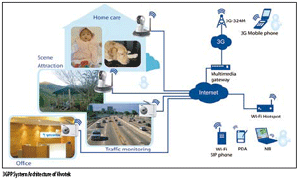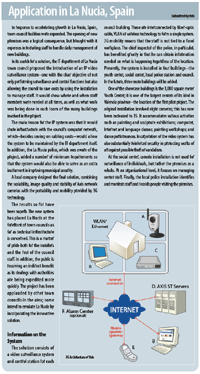Mature third-generation technology is enabling more applications over mobile devices, and with this, mobile monitoring over personal handsets that provide instant video has become a noticeable trend. IP cameras supporting 3G transmission and mobile surveillance are revolutionizing the security industry.
Mature third-generation technology is enabling more applications over mobile devices, and with this, mobile monitoring over personal handsets that provide instant video has become a noticeable trend. IP cameras supporting 3G transmission and mobile surveillance are revolutionizing the security industry.
IP surveillance products that provide thi rd-generat ion (3G) mobi le communication services are making remote monitoring systems the new trend in surveillance. Now, anyone who wants them can just go to a depot and buy a DIY kit. Within minutes, the systems protect property and lives. Mobile surveillance is also making it possible to monitor and secure facilities anywhere, anytime.
With the advent of 3G transmission, live video is available over mobile devices, including cell phones and PDAs; through easy installation of IP cameras, instant images are also accessible. Motion detection, snapshots of intruders, transmission of alarms to cell phones are all available, creating a better platform for mobile surveillance. "3G surveillance over mobile devices is not being adopted by most users in security. It takes time to change buying behavior, to move from viewing at the monitoring center or PC to mobile devices," said Steve Chen, Vice President of Alpha Pricing.
Viewing what happened in time is better than using footage or recording. "IP cameras with 3GPP transmission provide the accessibility to monitor via mobile phones in case of emergency and PCs are not available," pointed out Chen. "This value-added function enables supervisors to get instant notification when they are not in the office."
Security Industry to Benefit from 3G Evolution
Previous, second-generation technology had several problems, such as lower

bandwidth that allowed fewer than three pictures per minute; real-time mobile surveillance was not possible. Cell phones also required extra software to transmit real-time images; most consumers did not even know that they could download software to cell phones for monitoring. "Most cell-phone users, at least 90 percent of customers, do not even know that their cell phone supports software downloads to cell phones. Forget about them knowing anything about monitoring via cell phones," said Steve Ma, Marketing Director at Vivotek.
"Monitoring your home or office over the cell phone is not that difficult," continued Ma. "With cell phones that support 3G transmission and IP cameras, users just click on Real Player or Media Player, which are available in every 3G cell phone. Afterward, they can just enter the IP address of the IP camera that they wish to monitor and everything is finished." According to Chen, 3G transmission enables many value-added services, such as music or news broadcasting. That said, 3G applications in security remain limited. "It takes time for people to experience the benefits of mobile surveillance, but the potential is real."
Telecom operators, however, are investing heavily in 3G mobile surveillance. "The business model is to bundle their products with those from IP camera manufacturers," said Anderson Tsai, Vice Director of the Integrated Services Division at UniSVR. "Users need to pay only monthly fees to telecom operators for a one-year or two-year contract. It is really affordable for most families."

ISP Plays an Important Role
Internet service providers (ISPs) play an important role in 3G mobile surveillance. "3G surveillance systems transmit multimedia data via ISP and 3G vendor network systems to 3G receiving devices, such as a 3G cell phone," said Chen. "For a 3G surveillance to work over the cell phone, an ISP is required. If communication is 3G-compatible, ISP is not necessary for transmission. That said, for a 3G cell phone to receive 3G transmission from a device other than a 3G cell phone, ISP is definitely required." 
"ISP provides users with alerts or alarms via SMS messages to user cell phones when cameras capture something," said Philip Siow, Senior Technical Manager at Axis Communications. "That means that users can log onto IP cameras to view what is going on."
In addition, according to Siow, integration of ISPs, telecom companies and mobile operators is ready. "With our solution, service providers can offer customers the benefits of fully digital surveillance solutions by combining Internet and mobile services." Customers can easily deploy network video monitoring in offices, stores or homes with end-users then viewing live and recorded video from standard PCs and mobile phones.
Software
Software is a crucial component in

designing user-friendly interfaces and easier operation. "Software," said Tsai, "creates a new viewing page over the cell phone so users do not need to remember the camera's IP address. All they have to do is just type in their user account and password just like they do when checking e-mails."
Moreover, said Tsai, difficulties caused by different standards used by different telecom operators have been overcome. This means that software can bridge various platforms. "3G cell phones enable users to access the system to view IP cameras even when they are abroad."
Key Criteria for 3GPP IP Cameras 
Surveillance cameras used in these kinds of applications are designed for simple self-installation. All that is needed is power and an Internet connection. Once installed, cameras automatically register at service provider portals, offering end-users immediate access to personal monitoring systems after registration. A personal monitoring page allows for easy-to-use video monitoring, recording, scheduling of notifications and more.
"The system requires little or no management by the end-user," said Siow. "Updates can be handled automatically by the service provider and cameras are constantly checked for malfunctions."

Advances in mobile phones and IP cameras have created a new stage for security. The following are some of the features that 3GPP IP cameras deliver:
Self-developed SoCs provide high-quality video compression (MPEG-4 and MJPEG with dual codecs). This saves network bandwidth, while delivering high-quality video. Optimal synchronized video and audio ensure real-time transmission.
High-quality lensalong with varifocal auto iris lensmodules deliver clearer images.
Motorized pan and tilt with 4X digital zoom increases monitoring range and

eases burden of installation.
Compatibility with 3GPP and ISMA means that users can directly employ built-in, RTSP-compatible multimedia software on 3G cellular phones to view live video anywhere, anytime.
Built-in Web servers enable users to easily access systems via browsers with Internet Explorer.
Extended I/Os for sensors and alarms with motion detection strengthen surveillance.
UPnP and DDNS helps users solve floating IP problems. It also enables them to set up network cameras in a short period of time.
WEP or WPA encryption ensures tamperproof security.
Free, bundled professional IP surveillance and recording software allows users to monitor live synchronized video and audio from up to 16 cameras located in different places on a single screen, archive video and audio to hard drives, and search or play back stored video and audio.